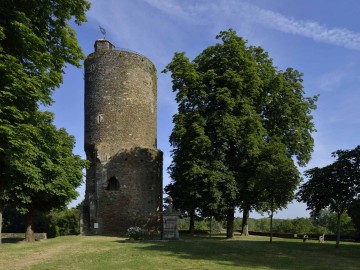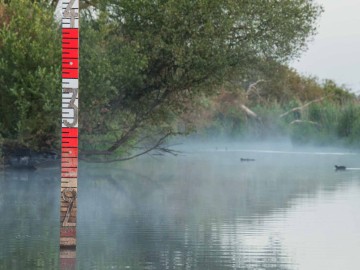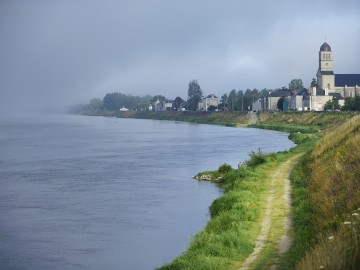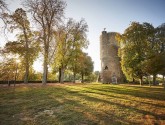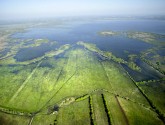Discover the region's myths and legends!
Follow the traces of Atlantic Loire Valley's many legends. At sites that form the settings for these marvellous tales, myth and reality intermingle in surprising ways to inspire the dreams of young and old alike...
Herbauges, the sunken town – Loire-Atlantique
Located in Pays de Retz, the lac de Grand-Lieu is enveloped in a mysterious aura. It is said that this huge body of water covers the remains of a sunken town that was once called Herbauges. In the 6th century, a time of widespread debauchery, the Bishop of Nantes asked Saint Martin de Vertou to evangelise the population. However, the inhabitants unresponsive to Christianity, and divine anger soon thundered down. God ordered Martin to leave the place within the hour. Under torrential rain, the deacon fled with Romain and his wife – the only two people he had converted – ordering them to walk with their heads lowered, without turning back. But the wife could not resist, and stopped. She barely had time to watch Herbauges being submerged by the water with a roar before she turned to stone. It is said that nowadays, every 24 December, keen ears may hear the sound of the midnight bells ringing out from the vanished town at the bottom of the lake...
The frightening ferryman of La Bohalle – Anjou
Located near Angers, La Bohalle is a peaceful little town on the banks of the Loire. It was officially founded by Jean Bohalle, who was in charge of collecting the tithe for King René in the 15th century. However, legend has it that another Jean – this time Bouhalle – created the village... A ferryman on the Loire, he was a character as unsettled as the river water: he would rob the travellers he took across it. One winter's day, he invited a rich merchant on his boat and tried to steal from him. The merchant handed over his purse, which Jean began to empty. Miraculously, it refilled as if by magic as soon as it was emptied of its contents! Wild with glee, the crook loaded his boat with coins until it began to sway, throwing him overboard into the freezing water. He begged God, promising to do the right thing, and was miraculously saved. The convert went on to found a nursing home and a chapel, around which the houses that formed the first village of La Bohalle would stand.
The devil's chair – Mayenne
At the southern tip of the municipality of Aron, on the edge of the road that links Mayenne with Jublains, stands a large granite stone with a very unusual shape. It is known as the Chaise du Diable or Devil's Chair, as the devil is thought to have sat there to dwell on his anger at the inhabitants of the village, who had played a dirty trick on him. At that time, the workers building the road were desperately trying to create a path for it through the tarns, but their work was destroyed by the water. The devil offered to help them build a bridge, in return for the soul of the first person to cross it. The agreement was made and the bridge built, but the poor villages couldn't bring themselves to sacrifice a man, deciding instead to send a cat in his place! Wild with rage, the devil went away to sit on the famous rock. The hollows in the stone are said to correspond to the imprints left by his twitching legs. At the base of the chair, you can also make out the marks from his claws...
The château de Juillé and the Templars' Treasure – Sarthe
It's no surprise that archaeologists and historians are particularly interested in the château de Juillé, located north of Le Mans. The building's ruins hold many secrets, the most unique of which relates to the Trésor des Templiers or Templars' Treasure, hidden in a cellar under the monument's tower! It is said that a wall opens up at the twelve strokes of midnight on Christmas Day, revealing the riches, before closing up again immediately to teach a lesson to overly curious visitors. Hubert de Faudoas, the knight tasked with guarding the Temple's gold in the 14th century, apparently stored the priceless bounty in the keep to protect it from the coveting hands of royalty. Before being burnt at the stake he could have given the information to his children, but they chose to shun the fortune and live modestly in order to be left alone by the authorities. The secret was long passed down from father to son, until Paul Duvallin revealed the story in 1879, saying that it had come from one of his ancestors. Meanwhile, the château had been demolished in the 16th century, on the order of Henry IV. Only the famous keep remains to this day...
A tower built by the Mélusine fairy – Vendée
In the fortified town of Vouvant there stands an impressive 45-metre-high tower. The last remnant of the château des Lusignan, which stood here in the 13th century, it is said to have been built in just one night by the Mélusine fairy! This notorious builder is thought to be behind many constructions in Western France, including châteaux, monasteries and fortresses. Legend has it that the women with the serpent's tail worked throughout the night, hidden from sight, transporting huge quantities of materials with incredible ease. If someone happened to come across her, the consequences would be terrible, and Vouvant was condemned to have one stone knocked down every year. This is why there is very little left of the fortifications built around the town! The Tour Mélusine or Mélusine Tower remains the most complete vestige and can be visited to this day, with tourists able to rent the keys to its two vaulted rooms. If you climb to the very top, you'll discover an amazing panorama over the Vendée countryside and the Mervent-Vouvant forest where, according to some, the fairy still hides to this day...



